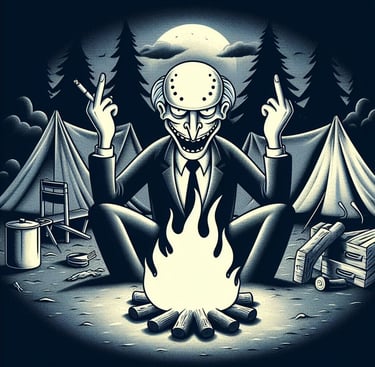“When the Trail Turns Toxic”
“When the Trail Turns Toxic” is a critical exploration of the darker side of Hash House Harrier culture, highlighting the ways cliques, ego-driven leadership, and lack of accountability can turn an inclusive community into a toxic environment. Written with firsthand insight and journalistic clarity, this column examines how silence enables harm and why real change begins with honest reflection. A must-read for anyone who believes hashing can — and should — be better.
Mr. Burns
4/29/20253 min read


When the Trail Turns Toxic: Examining the Darker Side of Hashing Culture
By Jeremy Marquardt – Independent Columnist
Once a countercultural curiosity, the global community of Hash House Harriers (HHH) has long sold itself as “a drinking club with a running problem.” With its offbeat blend of irreverent traditions, social bonding, and physical activity, the group has attracted a dedicated following of runners, drinkers, misfits, and military members in nearly every major city across the world.
Yet, behind the costumes, beer songs, and nicknames lies a darker undercurrent — one that has gone largely unspoken within many hashing circles. In some chapters, particularly in parts of the U.S., the playful chaos has shifted into something more corrosive: a culture that punishes dissent, protects toxicity, and alienates the very people who try to improve it.
The Volunteer Paradox
At the heart of every kennel (chapter) are its volunteers — members who manage trails, events, websites, social media, and more. These individuals give their time, money, and effort to support the group’s continued existence.
But in multiple documented cases, including recent events in the Pacific Northwest, these same volunteers have found themselves targeted by internal cliques and power structures. Their ideas are dismissed, their motives questioned, and their labor taken for granted.
Rather than being valued, vocal members who advocate for transparency or modernization are frequently treated as adversaries. The result? Burnout, public conflicts, and a revolving door of once-passionate participants who ultimately walk away.
Leadership Without Accountability
Most hash chapters maintain a loose structure of "mismanagement" roles — intentionally tongue-in-cheek titles like Grandmaster, On-Sec, and Religious Advisor. While these positions are framed in humor, they often carry real influence over group decisions, events, and social dynamics.
Unfortunately, in the absence of clear guidelines or accountability mechanisms, these leadership roles can become shields for ego-driven behavior. Reports have emerged of individuals in power using their positions to silence dissent, control narratives, and punish members through social exclusion or public shaming — all under the guise of protecting the group’s “fun.”
What begins as satire can quickly evolve into authoritarianism — and too often, there are no systems in place to course-correct.
Safe Spaces in Theory, Not Practice
Hash groups frequently pride themselves on creating inclusive and body-positive environments. Slogans like “No means no” are regularly emphasized, and many kennels adopt written zero-tolerance policies for harassment.
But in practice, enforcement is inconsistent.
Well-liked or long-standing members who cross boundaries are often given a pass. In contrast, newer or less connected individuals who raise concerns are met with defensiveness, blame-shifting, or outright gaslighting. Rather than investigate issues or offer mediation, some mismanagement teams opt for silence — or worse, retaliation.
Multiple sources report a pattern of psychological safety being treated as optional — especially when addressing misconduct from those with social capital.
The Culture of Fear and Control
In toxic hashing environments, peer pressure is not just social — it’s structural. Speaking up can lead to ostracism, ridicule, or being labeled as “dramatic,” “disrespectful,” or “not fun enough.”
This culture of fear discourages honest dialogue and reinforces an atmosphere where loyalty is valued more than integrity. The result is a group dynamic where harmful behaviors are quietly tolerated, while well-meaning members are pushed out under the weight of accumulated hostility.
In some cases, even non-controversial attempts to improve communication or accessibility — such as creating online resources, streamlining event planning, or clarifying rules — are met with resistance or sabotage by those invested in maintaining the status quo.
The Military Connection
Hashing’s close relationship with military communities has also complicated these dynamics. On one hand, the informality of the Hash provides a much-needed outlet for stress relief and camaraderie among service members.
On the other hand, the imported culture of hierarchy and chain of command has, in some kennels, further entrenched unaccountable leadership models. When military-style loyalty combines with alcohol, clique dynamics, and a lack of outside oversight, it can create an ecosystem where abuses go unchecked and younger or less empowered members are left unprotected.
A Community at a Crossroads
Hashing remains a vibrant and joyful tradition for many. But for others — especially those who’ve witnessed or endured the underbelly of the culture — it has become a painful reminder of how easily good intentions can curdle when egos, power, and silence are left unchecked.
This is not a call to abandon the Hash. It is a call to examine it. To acknowledge that toxic conditions do not self-correct — they require active intervention. To recognize that fun and accountability are not mutually exclusive. And to ask, honestly: who are we protecting when we look the other way?
But the story doesn’t end there.
Across the broader hashing community, many kennels have started asking the hard questions — and more importantly, answering them with action. They’ve adopted transparent policies, addressed long-standing behavior issues, and created safer, more inclusive spaces that still hold onto the chaos, weirdness, and laughter that makes hashing what it is.
These groups prove that change is not just possible — it’s happening.
They are choosing consent over coercion.
Openness over ego.
Community over clique.
And in doing so, they’re showing that hashing can evolve without losing its soul.
If hashing is truly about movement, then the best thing we can do is keep moving — toward a trail that’s better for everyone.



